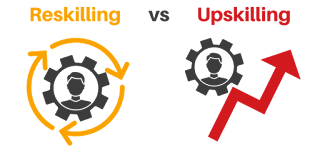The World Economic Forum 2018 report says that 75 million jobs will be displaced by 2022 in the 20 fastest-growing economies. At the same time, some 133 million+ new job roles are expected to be driven by a fast-paced technology revolution and continuous digital transformation. As major economies will face demand for new candidates with unique skill sets and capabilities which require the current and future workforce to reskilling and upskill to develop the skills needed to remain ahead in the competition.
Reskilling versus upskilling:
Upskilling is the process of learning an entirely new set of skills and facilitating skill-building based on the foundation of existing skills. Usually requires further training or education opportunities to grow in a field of expertise and can be executed through mentoring programs, online courses, workshops, or other micro-learning methods.
Upskilling and Reskilling are considered effective strategies for employers to hone their professional skills to combat perennial skills shortage.
Reskilling is the process of gaining new skill sets, sharpening their learning skills according to a new job, or of training people to do a different job. If you want to change your career path, or due to the emergence of new roles and technology, you will always find room for growth.
Reskilling includes professionals or learners with lateral skills that are close to the new skills your company requires. However, upskilling includes teaching new and advanced skills to employees to bridge the gap between their talent and helps them to advance along their current career path. These long-term employees have been working with your organization for several years and have a deep understanding of work culture and customers.
Globally organizations started workforce development programs to bridge the prevalent skills gap. Taking slow action or no action on skill development initiatives will affect your company’s ability to meet its long-term goals. Managers need to identify and address their lack of essential skills for an individual employee who is moving into new positions.
Retaining employees in the organization is struggling today, as employees expect more than salary and look for professional growth. Employees want to use their talent for an outranked salary, working with a dream employer.
Addressing the skills gap with career pathing:
Both reskilling and upskilling strategies should be implemented in your business to advance personal career development.
A competency-based approach allows your organization to evaluate and assess the specific competency required for each job role and understand the skills development required for employees who are in the transitioning phase of their career path. The right career path helps individual employees to break down the steps needed to achieve career progress through promotion. It requires an understanding of skills and knowledge required to identify the need for new skills and additional training to reach their long-term career goals.
The benefits of career pathing include:
Meeting future market demand: and identifying the capabilities required for the development of key skills for your existing workforce.
Identify hidden skills: Empowers your employees to assess their own potential and develop their skill set.
Create a culture of talent mobility: Employees look for employers with a commitment to their future career development, as it increases motivation and retention levels among your employees. Somewhere your organization demonstrates that your organization values its employees and their talent.
Employers and employees who invest in the ongoing development of their employees, embrace opportunities to grow and help to navigate the advancements as they need to. Continuous learning helps in employee retention and can help employees to navigate many different career shifts.
Take Free Online Courses
Digitalization and increased usage of social media tools help access education online, which is affordable and relevant to your interests.
As organizations are adopting technology to remain competitive, they require a workforce with the necessary skills. Improved access to education and training helps deliver flexible programs with new modes of delivery. Refining workers in accordance to skill sets can cope up with competencies needed in the workplace. Competency urges shift towards skill and accelerates career progression.
Upskilling, Reskilling & Continuous Learning assists in Talent Retention:
Continuous learning strategy contributes:
Adopt new technologies & trends
Increase cross-team collaborations
Boost team morale
Increase customer satisfaction
Increased employee retention
Foster adaptability
Lastly, continuous education can help companies save time and money both, looking for new human resources.
Continuous learning programs provide numerous opportunities:
Eventually builds employee trust
Increases employee engagement ultimately generating more revenues.
Gain the trust of employees as it shows they care for employee growth. Upskilling and reskilling help in huge retention and acquisition of employees.

Zeina Hijazi is a professional lebanese trainer for training of trainers (TOT) at ecadema.




No comments:
Post a Comment